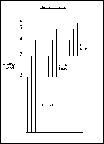Production of EMR
- Light is produced when electrons loose energy when jumping from
one energy level to a lower energy level. Energy, like mass, is conserved,
so if an electron looses energy it must go somewhere. It goes into the production
of a wave of electromagnetic radiation.
- Depending on how much energy is lost by the electron, an electromagnetic
wave of varying
 energy (or wavelength or frequency) is produced. The amount of energy emitted
is exactly equal to the difference between the two energy levels of the electrons.
energy (or wavelength or frequency) is produced. The amount of energy emitted
is exactly equal to the difference between the two energy levels of the electrons.
- Electrons can only emit energy if they have absorbed some energy. There
are several ways to excite electrons: heat, high voltage, and other EMR.
- Observations made by observing the EMR emitted when atoms are excited convinced
Bohr that electrons must only be able to exist at specific energy levels and
thus must only be able to orbit the nucleus at specific distances.
- See here an
applet depicting Bohr's model of the atom and how electrons absorb and
emit electromagnetic waves. This applet was created by folks at the Physics
2000 website produced by the University of Colorado at Boulder.
 energy (or wavelength or frequency) is produced. The amount of energy emitted
is exactly equal to the difference between the two energy levels of the electrons.
energy (or wavelength or frequency) is produced. The amount of energy emitted
is exactly equal to the difference between the two energy levels of the electrons. energy (or wavelength or frequency) is produced. The amount of energy emitted
is exactly equal to the difference between the two energy levels of the electrons.
energy (or wavelength or frequency) is produced. The amount of energy emitted
is exactly equal to the difference between the two energy levels of the electrons.